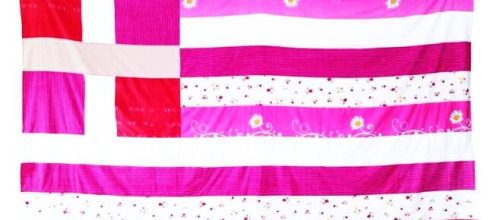"Women; Is it time to retire the word feminism?" That’s the question headlining Slate magazine on Dec. 23.
A distinction with a difference
The story tells of a random poll taken of people in seven European countries asking if they are feminists. A large majority (80-91 percent) said they believe men and women should have equal rights. But far fewer (8 – 40 percent) said they were feminists.
The “f” word aside, art show censorship at the Greek consulate in New York last week has me wondering if that random poll included people in Greece.
The theme of the show – domestic violence – was driven by the rising rate of female deaths from abuse in Greece.
And one of the displays called “Flag” by Georgia Lale was removed by order of Greece’s Minister of Foreign Affairs.
Seeing red
A far-right politician in Greece – Dimitris Natsiou – is said to dislike Lale changing the colors of his country’s flag from blue and white to pink and red, and that it was made with bed sheets that Greek women donated for the “Flag.”
Natsiou, who leads Greece’s ultra-religious Niki party, railed against “Flag” in parliament, calling it a “literal rag” and saying: “Our flag is blue and white, and it can be dyed red only on one occasion: with the blood of our heroes during national struggles.”
Apparently, women struggling against domestic violence are not heroic enough. Lale points out that the bedsheets were used by women who “stand up for their rights.”
In protest against the decision by the Minister of Foreign Affairs, members of the advisory arts committee for the exhibit said in a collective statement why they chose Lale’s work: “For its strong symbolism.
Unfortunately, the work has been misinterpreted and instrumentalized for political purposes, which have nothing to do with the social issue for which it was created.”
Of course, using a nation’s flag to protest a country’s wrongs is not new in the U.S. Faith Ringgold did this many times with the American flag. One of the wrongs she addressed was the inequality between men and women.
In 1964, she painted a woman set behind the stripes of the flag, as if they were prison bars.
Likely, Ringgold is best known for her “American People” series. One in the series, “The Flag is Bleeding,” made in 1967, questioning the American experience for people of color, was purchased by The National Gallery of Art in D.C.
Harry Cooper, senior curator and head of the Department of Modern and Contemporary Art, commented on the purchase: “This may well be the most important purchase of a single work of contemporary art since the National Gallery acquired Jackson Pollock’s No. 1, 1950 (Lavender Mist) in 1976.”
Weighing up a lacework of drips that conjures an atmospheric condition with dripping blood that conjures racial conditions in the U.S. is apples and oranges. Unless drips are the main idea. And in Ringgold’s work, it isn’t.
“The Flag is Bleeding” describes a semi-transparent American flag with its colors bleeding over three figures: a white man, a white woman, and a black man covering his bleeding heart as if pledging allegiance.
Far from “Lavender Mist” “The Flag is Bleeding” is a theoretical idea not unlike democracy itself. As Ringgold told the National Gallery, “The flag is the only truly revolutionary abstraction one can paint.”


